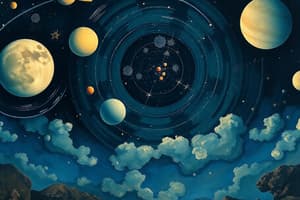Podcast
Questions and Answers
Which planet has no moons?
Which planet has no moons?
- Mercury (correct)
- Jupiter
- Mars
- Earth
Io is the largest moon of Jupiter.
Io is the largest moon of Jupiter.
False (B)
What is the diameter of Saturn's largest moon, Titan?
What is the diameter of Saturn's largest moon, Titan?
5,151 km
The moon of Earth is called __________.
The moon of Earth is called __________.
Match the following moons with their respective planets:
Match the following moons with their respective planets:
Which of the following moons is known for its icy surface and potential subsurface ocean?
Which of the following moons is known for its icy surface and potential subsurface ocean?
Deimos orbits Mars more quickly than Phobos.
Deimos orbits Mars more quickly than Phobos.
What is the diameter of Neptune's largest moon, Triton?
What is the diameter of Neptune's largest moon, Triton?
The second largest moon of Uranus is __________.
The second largest moon of Uranus is __________.
Which moon is primarily known for its geysers?
Which moon is primarily known for its geysers?
Flashcards are hidden until you start studying
Study Notes
Moons of Planets
-
General Overview
- Moons, or natural satellites, are celestial bodies that orbit planets.
- There are over 200 known moons in the solar system.
-
Mercury and Venus
- Mercury: No moons.
- Venus: No moons.
-
Earth
- Moon (Luna): The only natural satellite of Earth.
- Diameter: About 3,474 km.
- Distance from Earth: Approximately 384,400 km.
-
Mars
- Moons: Phobos and Deimos.
- Phobos:
- Diameter: About 22.4 km.
- Orbits Mars every 7.6 hours.
- Deimos:
- Diameter: About 12.4 km.
- Orbits Mars every 30.3 hours.
- Phobos:
- Moons: Phobos and Deimos.
-
Jupiter
- Moons: 79 plus notable Galilean moons.
- Io: Volcanically active; diameter ~3,643 km.
- Europa: Icy surface; potential subsurface ocean; diameter ~3,121 km.
- Ganymede: Largest moon in the solar system; diameter ~5,268 km.
- Callisto: Heavily cratered; diameter ~4,821 km.
- Moons: 79 plus notable Galilean moons.
-
Saturn
- Moons: 83 confirmed.
- Titan: Largest Saturnian moon; thick atmosphere; diameter ~5,151 km.
- Rhea: Second largest; diameter ~1,527 km.
- Enceladus: Known for geysers; diameter ~504 km.
- Moons: 83 confirmed.
-
Uranus
- Moons: 27 known.
- Titania: Largest moon; diameter ~1,578 km.
- Oberon: Second largest; diameter ~1,523 km.
- Miranda: Notable for extreme geological features; diameter ~471.6 km.
- Moons: 27 known.
-
Neptune
- Moons: 14 known.
- Triton: Largest moon; retrograde orbit; diameter ~2,710 km.
- Nereid: Notable for highly eccentric orbit; diameter ~340 km.
- Moons: 14 known.
-
Dwarf Planets and Other Bodies
- Pluto:
- Moon: Charon; diameter ~1,212 km.
- Eris: Moon: Dysnomia; diameter ~700 km.
- Pluto:
-
Key Facts
- Moons can vary widely in size, composition, and geological activity.
- Some moons may possess conditions suitable for life, particularly Europa and Enceladus.
- The study of moons provides insight into the history and evolution of their parent planets.
General Overview of Moons
- Moons, also known as natural satellites, orbit planets and there are over 200 identified in the solar system.
Mercury and Venus
- Mercury: Lacks any moons.
- Venus: Also has no moons.
Earth
- Moon (Luna): Earth's sole natural satellite.
- Diameter of the Moon: Approximately 3,474 km.
- Average distance from Earth: Around 384,400 km.
Mars
- Mars has two moons: Phobos and Deimos.
- Phobos:
- Diameter: About 22.4 km.
- Completes an orbit around Mars every 7.6 hours.
- Deimos:
- Diameter: About 12.4 km.
- Orbits Mars every 30.3 hours.
Jupiter
- Jupiter boasts 79 known moons, including the notable Galilean moons.
- Io:
- Highly volcanically active; diameter of ~3,643 km.
- Europa:
- Features an icy surface and potential subsurface ocean; diameter of ~3,121 km.
- Ganymede:
- Largest moon in the solar system; diameter of ~5,268 km.
- Callisto:
- Heavily cratered surface; diameter of ~4,821 km.
Saturn
- Confirmed moons: 83.
- Titan:
- Largest moon of Saturn; possesses a thick atmosphere; diameter of ~5,151 km.
- Rhea:
- Second largest Saturnian moon; diameter of ~1,527 km.
- Enceladus:
- Known for its geysers; diameter of ~504 km.
Uranus
- Uranus has 27 known moons.
- Titania:
- Largest moon; diameter of ~1,578 km.
- Oberon:
- Second largest; diameter of ~1,523 km.
- Miranda:
- Notable for extreme geological features; diameter of ~471.6 km.
Neptune
- Neptune is known to have 14 moons.
- Triton:
- Largest moon with a retrograde orbit; diameter of ~2,710 km.
- Nereid:
- Notable for its highly eccentric orbit; diameter of ~340 km.
Dwarf Planets and Other Bodies
- Pluto:
- Has one moon, Charon; diameter of ~1,212 km.
- Eris:
- Contains moon Dysnomia; diameter of ~700 km.
Key Facts
- Moons exhibit significant variability in size, composition, and geological features.
- Some moons, like Europa and Enceladus, may harbor conditions suitable for life.
- Studying moons yields crucial insights into the history and evolution of the planets they orbit.
Studying That Suits You
Use AI to generate personalized quizzes and flashcards to suit your learning preferences.



